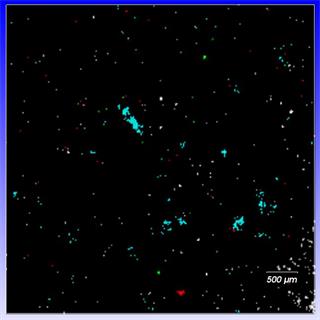현재 사용 중인 언어로는 이 페이지를 사용할 수 없습니다. Google Translate을 사용하여
자동 번역된 페이지
를 볼 수 있습니다. Renishaw에게는 이 서비스를 제공할 책임이 없으며 번역 결과를 저희가 확인하지도 않았습니다.
추가로 도움이 필요하시면
저희에게 연락해 주십시오.
Raman spectroscopy spots environmental microplastics
June 2018
Plastics are used extensively in products and packaging. Unfortunately, these make their way into the environment and cause significant pollution, not only as bulk material but also as microplastics: small, hard-to-spot, particles. A Danish research institute is using a Raman spectroscopy system, from Renishaw, to help its clients understand and reduce the amount of microplastics in the environment.
This is a research area where many uncertainties exist, with respect to both analysis and identification. The human health impact of microplastics is as yet largely unknown but is suspected to be significant. This work will contribute towards an increase in understanding and knowledge of the effects of microplastics.
Morten Køcks and colleagues at the Danish Technological Institute (DTI, Aarhus, Denmark) are working both with private companies and the Danish Environmental Protection Agency on technologies to remove plastic particles from the aqueous environment, for example, waste water. The aim is to improve the removal of microplastics at waste water treatment plants and at other local sources for waste water, such as laundries.
The first step is to develop robust methods of characterising and quantifying microplastics. Traditional laboratory techniques, such as gas chromatography / mass spectrometry (GC-MS), can quantify the amount of plastic, but do not give information on particle sizes or numbers, both of which are expected to be equally important. Infrared microscopy can do both, but is unsuited to analysing very small particles and is also challenged by the particle morphology. So, to provide a comprehensive analysis system, Køcks and co-workers have turned to Raman spectroscopy. They use their existing Renishaw inVia™ confocal Raman microscope so extensively that they purchased an inVia Qontor system, to increase their Raman capacity.
They take the waste water from the treatment plant, extract material of no interest (such as minerals and organic material), and analyse the residuals on a filter or flat surface. This involves using a range of advanced features of the inVia microscope. The microscope automatically locates the particles and determines their sizes and statistics. Then it produces Raman maps of the particles, using height tracking to keep a good focus, and uses advanced spectral analysis to identify the plastics and inorganics. The result is a comprehensive set of data on the number, size, shape, and chemical composition of the particles.
The results are positive and indicate that the treatment plants already capture about 99% of the microplastic particles, making it possible to handle the microplastics at the plants. DTI is continuing to develop methods to provide more accurate results and to expand the research to also look at microplastics below 20 µm in size, rubber contamination from vehicle tyres in sewers and microplastic reduction at other local waste water sources, such as laundries. In addition, they are looking at the specific handling of the accumulated microplastics in sludge at the waste water treatment plants.
Please visit www.renishaw.com/polymers for further details on how Renishaw's inVia confocal Raman microscope is being used for plastic analysis.
Downloads
For further images, videos, company biographies or information on Renishaw and its products, visit our Media Hub.




